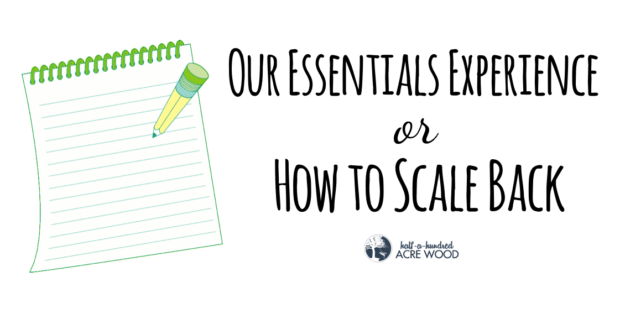
How much time does Essentials take for a 4th grade boy who is somewhat allergic to holding a pencil (aka, does-not-like-to-write-stuff syndrome)? How do you scale it back?
First, be encouraged! The first six weeks are like trying to take a sip out of a fire hydrant, but then we spend the rest of the year and repeat, and repeat, and layer and layer…. {Remember this!}
Before I offer our own plan, please first refer to the Essentials of the English Language (EEL) Guide and make sure you’re reading the entire lesson each week! (The guide offers schedules and scaling-back ideas!) Then, be sure to ask your Essentials tutor for their suggestions on ways you can scale back. I simply offer our own family’s experience and hope it is an encouragement to others.
When we first started Essentials, my child was 8 years old. He memorized all the charts orally but struggled with writing. I finally determined that my overall purpose was to make sure he knew the grammar. So… I let him dictate to me. We did lots of oral recitation and drills for our charts and definitions. He dictated his IEW papers to me. It helped tremendously! (We have attempted to learn typing, but he’s not there yet. Instead of having him focus on typing skills and coming up with words, we just focus on him coming up with the words.)
How we scaled back (for a student who has a real aversion to writing)
Each day at home:
- Practice one chart written per day, allowing your child to make reasonable abbreviations. For example, use N for noun, P for pronoun, etc. Just come to an agreement between the two of you as to what is an acceptable abbreviation. (As you work through the year, you will focus on learning the grammar of one or two charts at a time while reviewing the previous ones for continued mastery. See the Scope and Sequence Chart that is in your Essentials Guide on p. 395.)
- Practice all other charts and definitions for that week orally on a daily basis.
- Complete analytical task sheet for one sentence per day. (You do not have to do all five every week, especially when you get to second semester and/or are doing Quid et Quo on each sentence. Doing four sentences will be sufficient for first-year students.)
- Practice a “Question Confirmation Drill” aloud to master the question confirmation process.
- Split up your IEW assignment as follows: Day 1: KWO and/or brainstorm, Day 2: Dictate rough draft while mother types, Day 3: review and revise rough draft – add elements of structure and style according to checklist, Day 4: Finish revision, label final copy, and practice reading out loud twice to prepare to present.
- In some cases I joined the goals of two writing assignments together (especially when we went on trips while our community was in session). It was much more important to me that he understand and practice the concepts of structure and style rather than complete a certain number of assignments. Ultimately the parent is the teacher and should control the curriculum (instead of allowing it to control you). An overwhelming sense of trepidation and the act of shedding tears should not be a normal part of your writing routine. But if it has been, just know that you can recover from it. (I speak from experience.) My best lesson learned was that scaling back was not a bad thing – it returned the joy to our homeschool days and gave us a joy for writing! This year my son has gained so much autonomy and has improved his writing so much, it’s shocking.
- When writing his rough draft, it is still difficult for him to focus on getting the words out of his brain and onto the paper while focusing on the spelling rules, penmanship, and sentence structure/punctuation all at the same time. Thus, his rough draft is usually pretty rough! He later returns to his rough draft to edit his work. My lesson learned: Don’t expect him to get all the different elements of writing down all at the same time. When he’s completing his writing assignment, don’t get frustrated when he forgets the spelling rule you already covered in a previous spelling lesson. Instead, celebrate the success of his ideas and words flowing onto a piece of paper! Meshing all of these skills together takes practice, time, and maturity.
- As he has matured, we have also completed the Grammar Rules pages from the Student Resource Notebook (I believe with recent versions of the history-based writing lessons, the Student Resource Packet no longer includes these grammar rule exercise pages) and the Editing Exercises from the EEL Guide. Update: Since writing this post, we’ve discovered Fix It Grammar (try a sample here), which is a much better way to practice editing and gives a more structured method of learning sentence mechanics. We also use a separate spelling program due to our own preference.
- Note: Copywork/Penmanship is a skill we practice apart from Essentials work. I did not want handwriting to become the limiting factor of his mastery of English grammar and structure-and-style writing skills. We use Script-n-Scribe for handwriting practice.
This took us between 1 and 2 hours each day. I tried to take out the pain of holding a pencil as much as (reasonably) possible, focusing primarily on the mastery of the material itself. His handwriting will eventually catch up with his mental capacity. In fact, I saw a big difference between 3rd and 4th grade for him. Now in 5th grade, he is writing his entire rough drafts by hand, and he’s writing out his charts completely (with only a few abbreviations).
A few more thoughts
The few times we procrastinated on our IEW assignments, it led to great frustration! I found that cramming it all into one or two days actually cultivated a loathing of language, instead of a love for its beauty.
Our first two years of Essentials we scaled back and only focused on certain items. I constantly coached my son, as Andrew Pudewa states in his very helpful IEW seminar dvds. I would have my son dictate what he wanted for his paper while I typed his words. (As a 5th grader, he would write his rough draft. I would still type the final copy for him, but aside from that, he is became much more independent with this entire process.) If he had trouble picking out words for quality adjectives, I’d help him search through the Student Resource Notebook. If he had trouble restructuring a sentence to get rid of a banned word, I would offer part of a new sentence that he would repeat back to me and finish in his own words. I simply had to remind myself that he was learning a process, and, as I suspected, he has become more independent as we’ve layered the learning! That being said… if you have a reluctant writer, don’t be afraid to offer him/her ideas. The more we model it for them, the easier it gets!
Whatever is needed, equip your child to feel successful. You do not want him to absolutely dread writing for the rest of his life. Learn together. Laugh together. Enjoy the time as you learn how to write better together. Above all else, remember that Essentials is just one of many language arts programs. If it doesn’t work for you or your child, you are not a failure. There are other great options out there that will equip you to teach your children language arts.
100% Money-Back Guarantee
Because of IEW’s incredible 100% Money-Back Guarantee, we highly recommend purchasing products directly from IEW instead of through 3rd-party sellers.
Try out Writing, Spelling, Poetry, and Grammar Programs for Free!
We highly recommend checking out the first three weeks of Structure & Style for Students program from IEW. (You can access the first three weeks free.)
Other IEW programs you can try out for free include…
- Structure and Style for Students. If you’d prefer Andrew Pudewa to teach writing structure and style to your student(s), this program is for you! Download the first lessons from each level for teaching composition to children in grades 3-12.
- Fix It! Grammar. Download the first lessons of all four levels of this gentle introduction to grammar and mechanics with thorough yet simple instructions for the teacher.
- Introduction to Public Speaking. Download the first two lessons of this engaging program for learning to conquer the #1 fear of most people: public speaking.
- University-Ready Writing is a 12-week video-based course which teaches high school students advanced note-taking skills and writing techniques in preparation for college-level writing. Try it free here!
- Theme-Based Writing Lessons. Theme-Based Writing Lessons are for students and/or teachers familiar with IEW’s Structure and Style Program. Topics include science, history, literature, and Bible, covering a variety of grade levels.
- Linguistic Development through Poetry Memorization. Download the first five poems from this mastery approach to learning poetry.
- The Phonetic Zoo. Try a sample of a program that teaches spelling with an auditory approach towards mastery. (Requires free registration.)
- Free audio talks, booklists, and more! (Our favorite audio is Nurturing Competent Communicators.)
Visit IEW to find out more about other programs to transform your students into proficient writers – from early elementary all the way through college! You may also be interested in our favorite resources for teaching grammar and composition to students in grades 3-12. Be sure to listen to the many audio talks offered by Andrew Pudewa, and even subscribe to the podcast! Andrew Pudewa offers great encouragement and insight. He’s one of our absolute favorite speakers. Even our teenagers enjoy listening to him!
Again, this is just our own family’s experience. Be sure to also ask your tutor for ideas on how best to scale back. I truly hope this helps someone out there!
For more on Essentials, you can also reference these posts:
Essentials – Preparing for Essentials
Essentials Scheduling and Planning
Our Essentials Student Notebook

